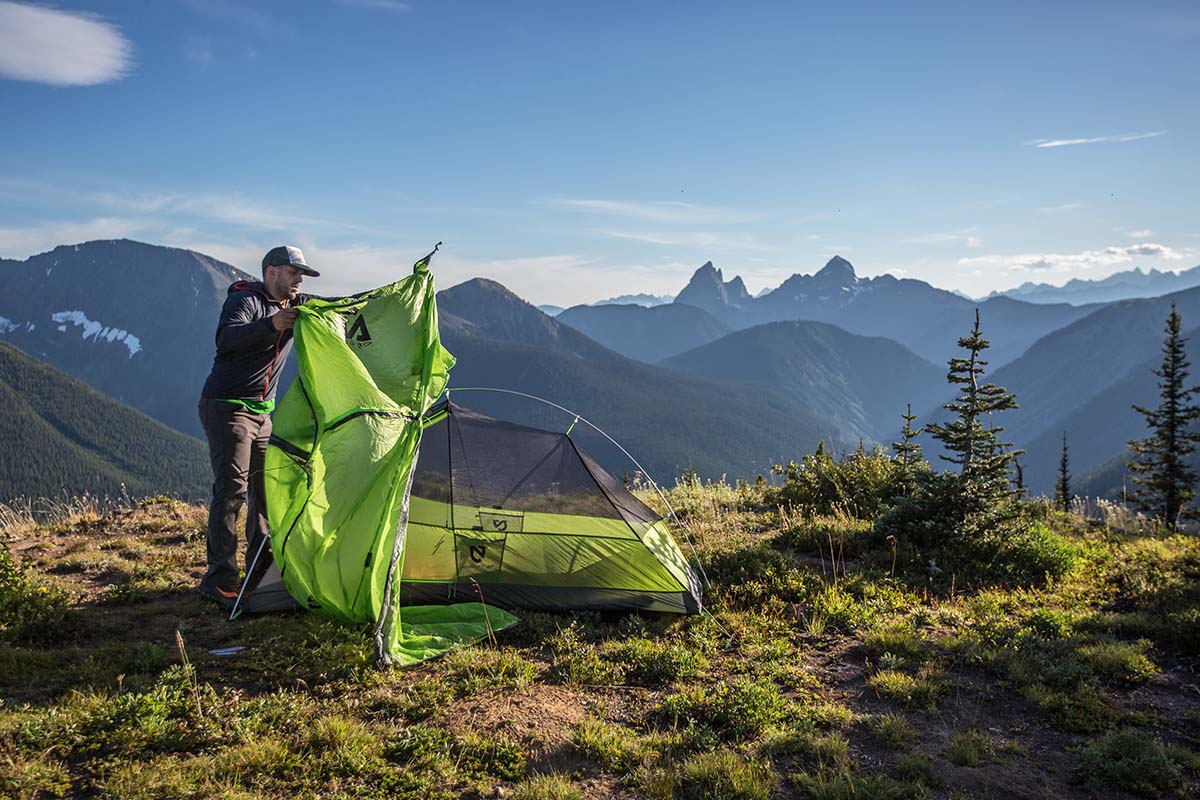

While ultralight backpacking gear used to be more niche, the past few years have seen a surge in mainstream brands integrating weight-saving designs and materials into readily available gear. One of the biggest areas that backpackers can shave weight is their tent: Traditional freestanding models can weigh 5 pounds or more, while some ultralight designs barely tip the scales at just over 1 pound. But before you take the ultralight leap, it's important to note that ultralight tents are not without compromises. Below, we provide information on the various weight classes of backpacking tents and outline potential trade-offs, many of which we've experienced firsthand. For a wider look at the market, check out our articles on the best backpacking tents and best ultralight tents.
Editor's note: We updated this article on July 8, 2025, to update our tent choices to the latest models and add relevant shopping and comparison advice. We also swept the guide to ensure all product references and specifications were accurate at the time of publishing.
Backpacking tents come in a range of sizes, from one-person to four-person models. To keep the comparisons simple, we’ve referenced all two-person tents here, which are the most common size. The tents are broken down into four categories based on weight: heavyweight, midweight, lightweight, and ultralight.
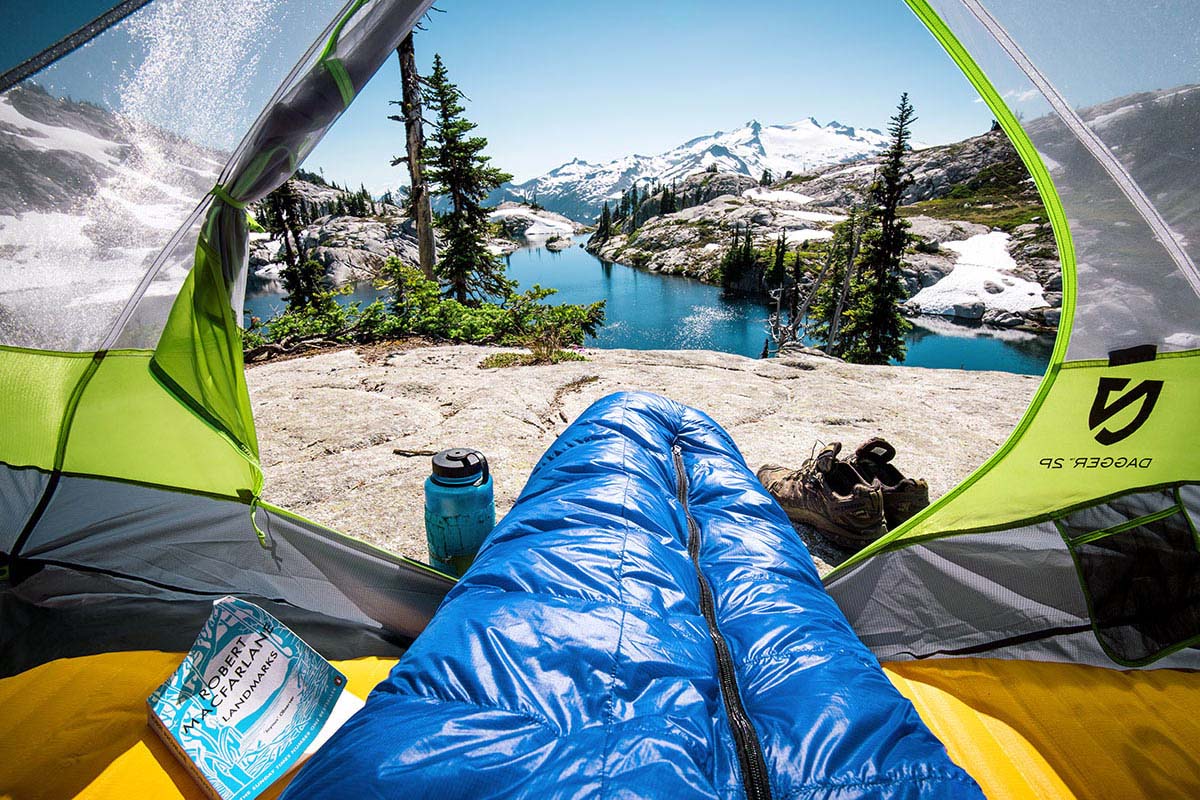
Heavyweight tents are fully featured backpacking tents that offer premium comfort, solid weather protection, durable materials, and typically a (relatively) low cost. Some two-person tents in this category can weigh 4.5 pounds or more, including popular models like the REI Co-op Half Dome 2 (5 lb. 15.1 oz.) and Marmot Tungsten 2P (5 lb. 14.2 oz.). Among these tents, we see the use of robust fabrics (floors from 40D and up), tall peak heights with broad ceilings and steep walls to maximize interior space, non-tapered floor plans, two doors and vestibules, and a variety of organizational features. In comparison to lighter tents, heavyweight tents excel in every metric but weight and are often the most affordable option for new or infrequent campers. These are heavy enough that we don't often recommend them for backpacking, but they can be a good starter model when split between two people.
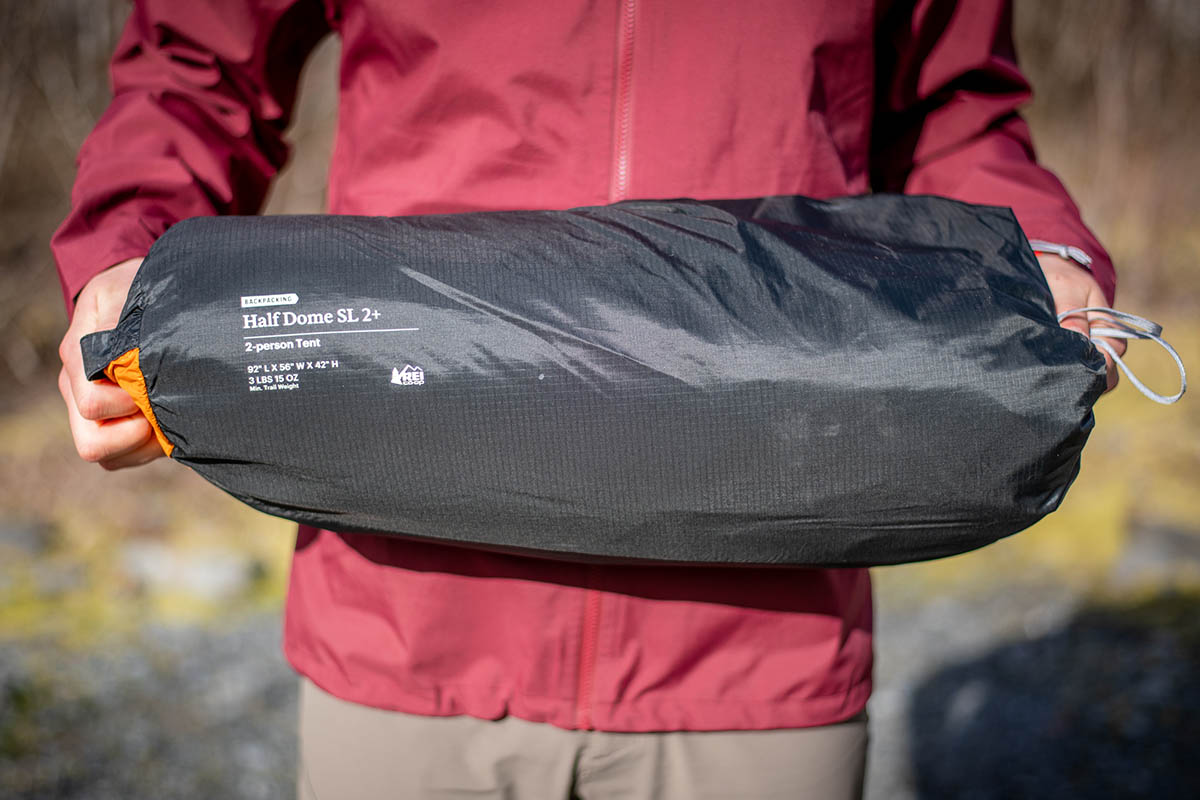
Midweight tents retain much of the comfort, interior space, and features of heavyweight tents but drop weight through the use of thinner fabrics. At the heavier end of this category is Nemo's popular Dagger Osmo 2P (3 lb. 15 oz.), while MSR's Hubba Hubba LT 2 (3 lb. 6 oz.) falls at the lighter end of the spectrum. These tents are still fully featured: You get uncompromised interior space and generous headroom without tapering, two doors and spacious vestibules, quality zippers, and a variety of interior pockets.

However, shaving weight often comes with sacrifices in durability. For example, the Hubba Hubba LT 2 uses relatively thin 20-denier (D) materials, while the heavier Half Dome has a 40D rainfly and 75D floor. Thinner fabrics (both solid and mesh) are more susceptible to tearing and developing holes, and ultralight zippers are more vulnerable to failure. A second sacrifice comes in terms of cost: Lightweight materials are expensive, and these tents are priced higher than heavier models due to their minimalist materials and designs. But for serious backpackers who cover longer distances, know how to take care of their gear, and don't want to totally eschew creature comforts, the weight and space savings are often worth it.
Tents in our lightweight category tip the scales somewhere in the 2- to 3.25-pound range, including the Big Agnes Tiger Wall and Nemo Hornet Osmo 2P (both 2 lb. 8 oz. all in). Lightweight tents often are made with similar fabrics as those in our midweight category—you don’t want to go much thinner than 15D for a tent floor—but their weight savings comes primarily by way of tapering (smaller floor space and more heavily sloped ceilings), fewer doors and features, and simplified pole structures. Sometimes, the result is a semi-freestanding design, which means you still get tent poles, but some corners must be staked out in order for the tent to remain upright.

Compromises in the lightweight category can include less headroom, a slightly more complicated setup (you’ll need good anchors for the stakes), and, in some cases, single-door designs. In other words, whereas durability takes a hit in the midweight category, the lightweight category is where we see comfort and livability start to decline. It's all about priorities, though—if you don't mind sacrificing some headroom and features and are willing to take added care when pitching and packing your tent, the drop in weight can be well worth the drawbacks. One of our favorite lightweight designs is Big Agnes' Copper Spur UL2, which checks in at a very competitive 3 pounds and offers a generous 29 square feet of interior space, two doors and vestibules, a simple freestanding setup, and plenty of features for most weight-conscious backpackers.
"Ultralight" is a broad and fairly ambiguous term, with no official weight class and a lot of brands using it as a buzzword. For the sake of this guide, we've narrowed it down to tents that weigh 2 pounds or less, although our ultralight tent round-up encompasses a broader range to include budget-friendly and four-season models. The majority of ultralight tents are non-freestanding designs, which means they are pitched using trekking poles and must be fully staked out (omitting tent poles can shave a lot of weight). Ultralight tents are also often single-wall designs, meaning the tent body and rainfly are combined in one layer of fabric. And finally, while the market has expanded substantially in the past several years, many UL designs—especially those that use trekking poles for support—are built by specialty cottage brands, including staff favorites like the Zpacks Duplex Zip (1 lb. 4.2 oz. excluding stakes) and Gossamer Gear's The Two (1 lb. 11.9 oz. all in).
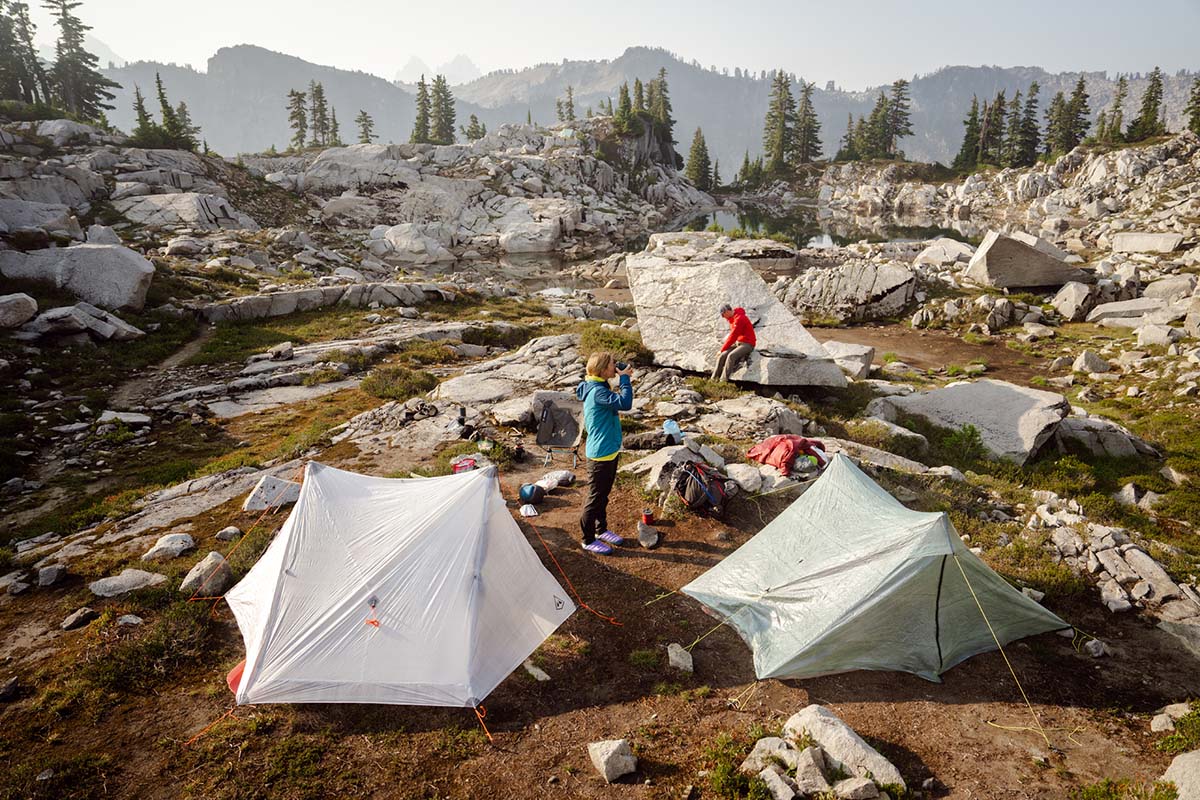
The compromises of ultralight tents are many. Single-wall tents suffer in terms of breathability, meaning that condensation is likely to collect on the inside. Further, although taped seams, waterproof materials, and DWR-coated nylon will keep most rain at bay, there’s less material between you and the elements, and the tent walls will feel damp when wet. Additionally, non-freestanding designs can take some tweaking to pitch, and you’ll want a taut and precise setup in the event of a storm. Even models like Big Agnes' Fly Creek HV2 Carbon—which are less compromised with their double-wall, semi-freestanding designs—take a hit in terms of durability and are among the most fragile backpacking tents on the market. Cost-wise, ultralight tents run the gamut from about $320 for a tent like Gossamer Gear's The Two to $700-plus for a Dyneema design like Hyperlite's Unbound 2 (see our in-depth review). In the end, we recommend tents in this weight class only for the most seasoned, weight-conscious backpackers.
Now that we understand the weight classes (and their pros and cons), here's how each category performs in terms of durability, weather protection, ventilation, and more. It's important to note that performance doesn’t drop with weight across the board, so be mindful of your priorities and well informed about the possible trade-offs when making your purchase. And while we did our best to provide a comprehensive overview, keep in mind there are always exceptions and outliers.

Backpacking tents in our heavyweight and midweight categories excel in interior space. You get rectangular floors that don’t taper at the feet and pole structures that result in near-vertical walls for a true dome shape with maximum headroom. On the flip side, models in the lightweight and ultralight categories generally make compromises in space and overall livability. Most in the sub-3-pound range will taper toward the feet, resulting in a smaller, more cramped interior that makes it difficult to sleep head-to-toe with your backpacking partner. They also use fewer tent poles (or substitute trekking poles), which means steeply tapered ceilings instead of the dome design and vertical walls of a more comfort-oriented model. Many lightweight or ultralight tents just have a small zone in the middle where you can sit up, whereas a heavier tent’s peak height might extend for almost the entire length.
Another livability consideration is the number of doors. In an effort to reduce the weight of zippers and vestibule material, lighter tents often just have a single door. One door at the head of the tent isn’t so bad (like what you get with the Big Agnes Fly Creek UL2), but a single door in the side can be annoying, requiring you to crawl over your tentmate to get in and out. Luckily, even most ultralight tents seem to have gotten the memo, and rarely do we see two-person tents with a single side door these days.
Heavyweight: Great
Midweight: Great
Lightweight: Good/fair
Ultralight: Fair/poor

One of the main ways manufacturers cut weight is through the use of thinner materials, meaning durability is a primary concern with lightweight and ultralight tents. A fabric’s thickness is usually measured in denier (D). The lower the denier, the thinner the material and the lighter the tent. There’s a wide range here, from 60 or 70D for heavyweight models down to just 15 or 20D in the lightweight and ultralight categories. Durability isn’t a huge differentiating factor at a certain point (you wouldn’t want to go any thinner than 15D for a tent floor), although in some cases, manufacturers will use fabrics as thin as 7D for the fly or employ ultrathin Dyneema Composite Fabrics (DCF). While DCF is known to be significantly stronger than nylon, the fabric is compromised when thin. For example, there’s a sizable drop in durability between the Zpacks Duplex (0.55 oz./sq. yd.) and Big Agnes Tiger Wall Carbon (0.34 oz./sq. yd.).
In addition to thinner materials, it’s also important to consider zippers and poles. Zippers can be a big point of failure, and tents with ultralight fabrics shouldn't be put under too much strain at closure points. We've seen a few tents rip at the zipper seam and minimalist zippers separate within a few seasons, plus it's easy for thin fabric to catch and rip in the zipper track. In terms of poles, some lightweight tents (like the MSR Hubba Hubba LT 2) use carbon composite poles, which are more likely to break under pressure. If you’re willing to suffer the slight weight penalty, aluminum poles are stronger and less expensive, which is often a nice compromise for ultralight designs. Alternatively, you can opt for a non-freestanding tent and use your trekking poles instead.
Heavyweight: Great
Midweight: Fair
Lightweight: Fair
Ultralight: Fair/poor
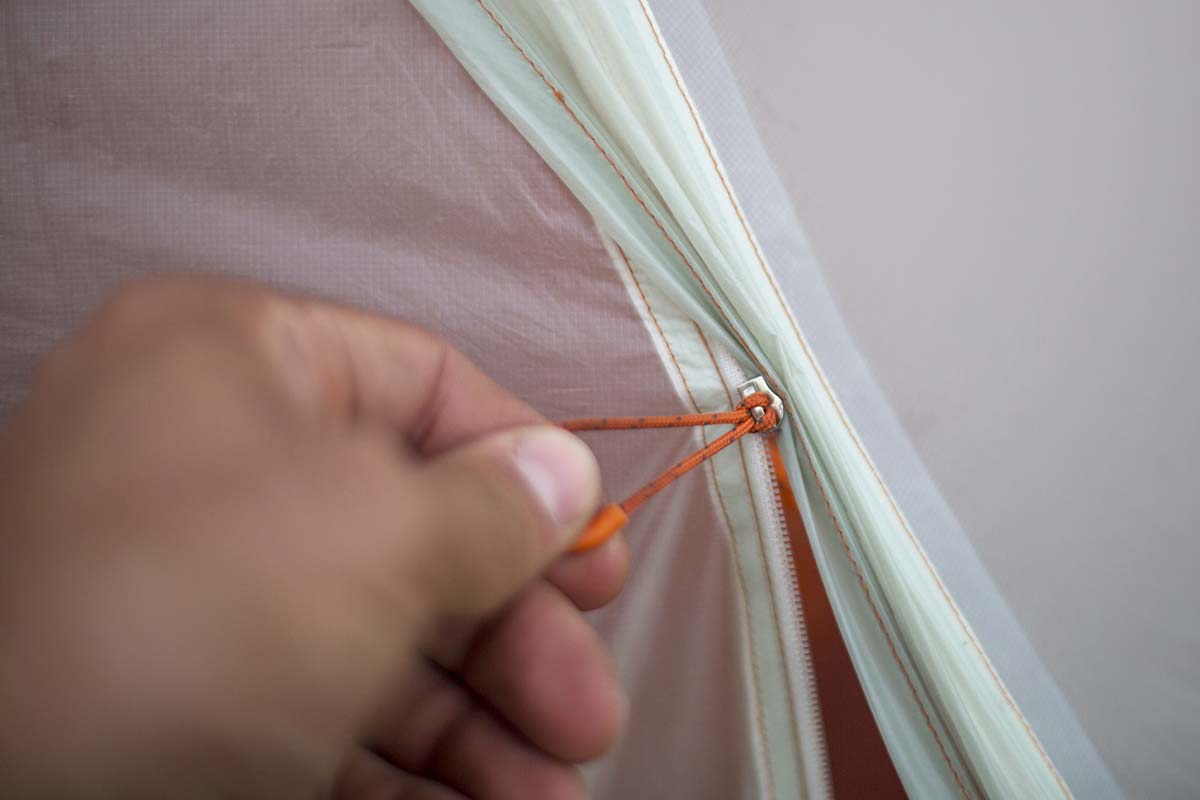
You can usually expect to get better rain and wind protection from a more robust tent, but many lightweight and ultralight models don’t lag too far behind. These styles give up a little assurance with their thin fabrics, which are more likely to rip in a serious squall (we have similar concerns about carbon fiber poles breaking). Additionally, many lighter tents, such as trekking-pole designs or semi-freestanding tents like the Big Agnes Fly Creek UL2, won’t be as sturdy in the wind as a domed design like the Big Agnes Copper Spur, so take care in how you orient your tent when setting it up. Think torpedo, not sail.
There's a small drop in weather protection between heavy/midweight and lightweight tents, but more of a discrepancy with ultralight designs. Because these tents are generally single-walled, you run the risk of the fabric wetting out and sagging in heavy rain, resulting in damp nylon against your body. Further, while trekking-pole tents can be quite stable when set up well—even in the wind—unreliable anchors or loose guylines can result in total disaster. For this reason, it’s important to double-check your non-freestanding tent to make sure it’s securely anchored and taut with all of the guylines at the correct angles. In the end, we think non-freestanding tents are a solid option for summer backpacking at low elevations, while heavier freestanding and semi-freestanding models can handle inclement weather with fewer compromises.
Heavyweight: Great
Midweight: Good
Lightweight: Good
Ultralight: Fair
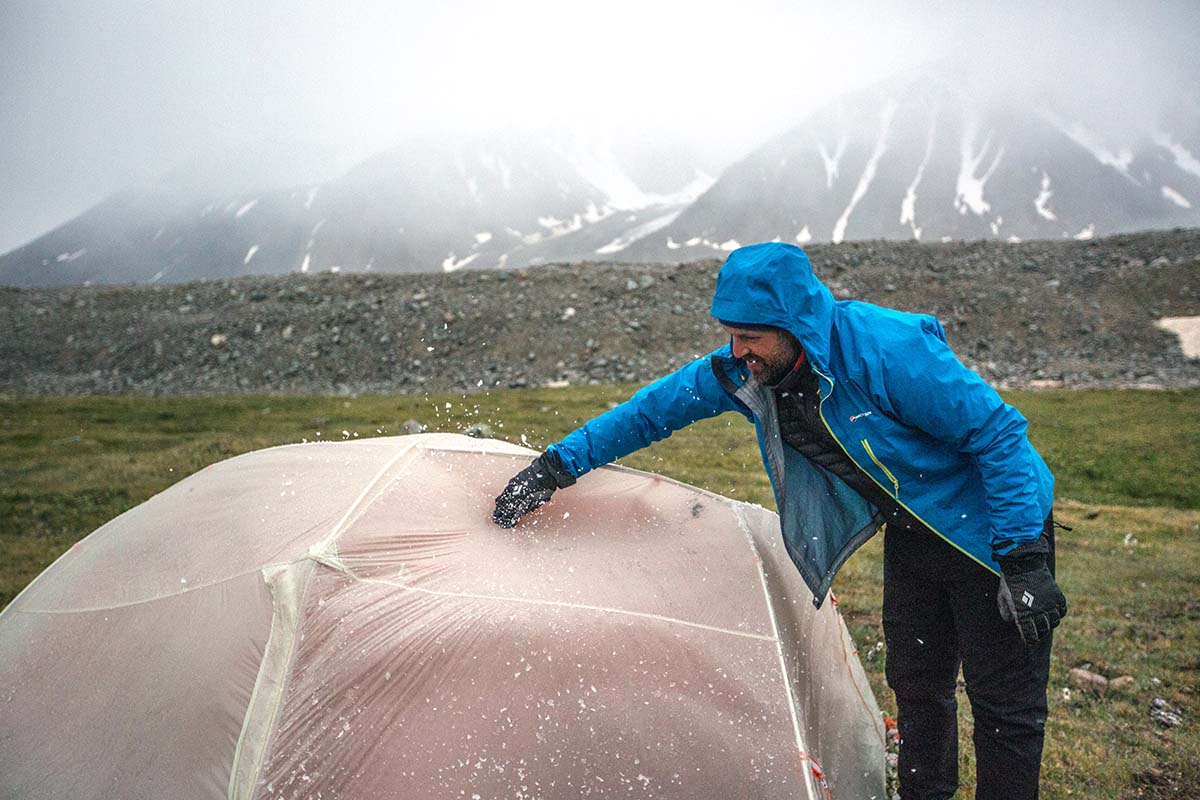
Most tents in our midweight and lightweight categories (such as the Nemo Hornet Osmo 2P and Big Agnes Copper Spur UL2) are just as breathable as their heavier brethren, with similar amounts of mesh in the body and room for airflow between the tent and rainfly. On the other hand, single-wall ultralight tents like the Zpacks Duplex and Duplex Zip typically suffer a good deal in terms of ventilation. Asking one piece of fabric to be both breathable and waterproof is a tall order, and Dyneema is especially lacking in breathability. It’s possible to increase venting by sleeping with the zippers partially open, and many designs do come with vents for promoting some airflow, but your options are limited in strong winds or rain.
Heavyweight: Great
Midweight: Great
Lightweight: Great
Ultraight: Fair
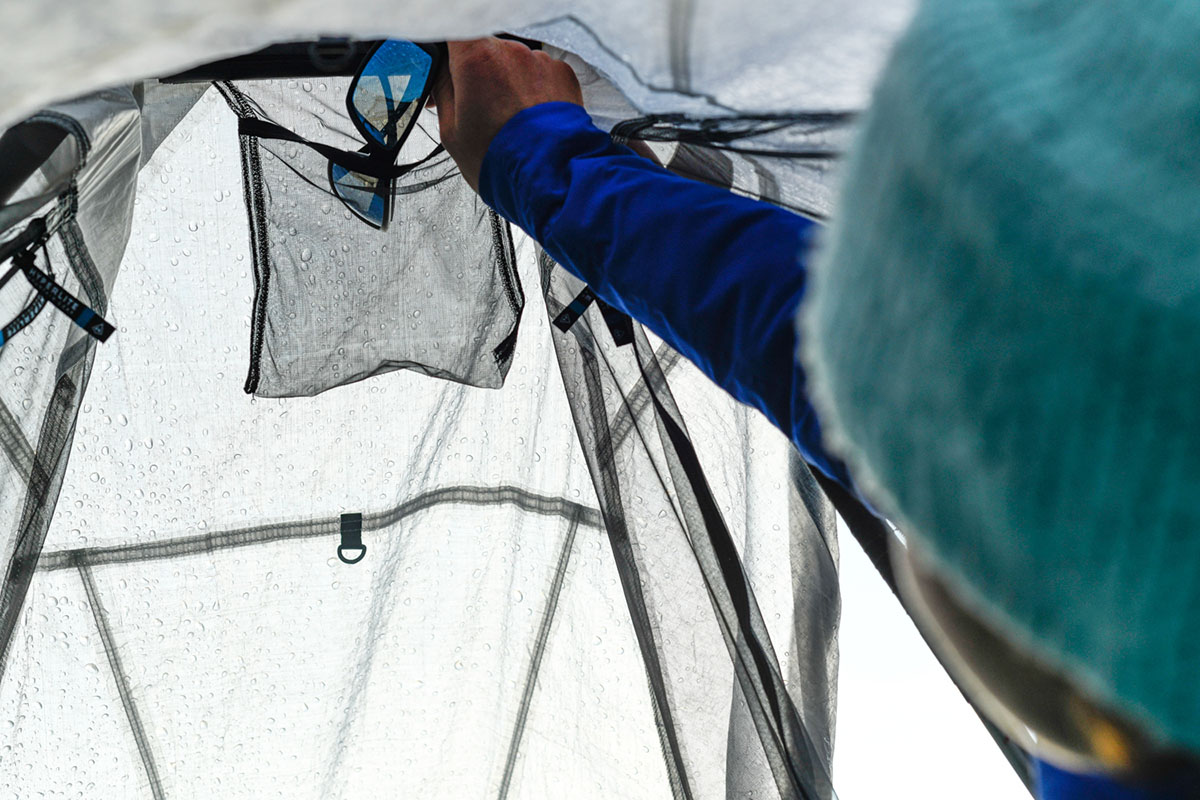
Tent storage can be broken down into two categories: vestibules (outside the tent) and pockets (inside the tent). It’s common for a tent to have a vestibule at each door, meaning a one-doored tent will have one vestibule and a two-doored tent will have two. These are useful for storing gear like backpacking packs and hiking boots, especially when interior space is limited. The good news is that most tents—regardless of weight class—prioritize exterior storage, with the vast majority featuring two vestibules. That said, vestibules do tend to get smaller as tent weight goes down.

In terms of internal organization, you can expect most weight-conscious designs to have significantly fewer pockets and hanging loops, particularly those in our lightweight and ultralight categories. For example, the REI Half Dome 2 (5 lb. 15.1 oz.) has a whopping eight total pockets (four along the roof and one at each corner), while most sub-3-pound tents often whittle your pocket options down to two (as seen in both Gossamer Gear’s The Two and REI Co-op's Flash Air 2). Interior pockets can be helpful for organizing smaller items like a headlamp or book, but they’re one of the first things we’re willing to give up in the name of shaving weight and bulk.
Heavyweight: Great
Midweight: Great
Lightweight: Good
Ultralight: Fair

When it comes to ease of setup, the majority of freestanding and semi-freestanding backpacking tents are easy to pitch in just a few minutes. The poles secure into hanging clips (very little sleeve threading anymore), and many modern designs have color-coded corners, poles, and buckles. You don’t compromise much in terms of ease of use with a midweight or lightweight design, but that’s not the case when it comes to non-freestanding ultralight models. For more advice on making the best choice, check out our article on freestanding vs. non-freestanding tents.
Non-freestanding tents—like most in our ultralight category—take more effort to dial in and can be more finicky. And once you set it up, you can't just pick it up and move it to a better spot 20 yards away. The one major benefit to non-freestanding tents is that they’re almost all one-piece designs, which means that once you get the process down, it’s fewer steps. You can also set up these tents in the rain without worrying about the inside getting wet, since the fly is part of the tent body.
Heavyweight: Great
Midweight: Good
Lightweight: Good
Ultralight: Fair
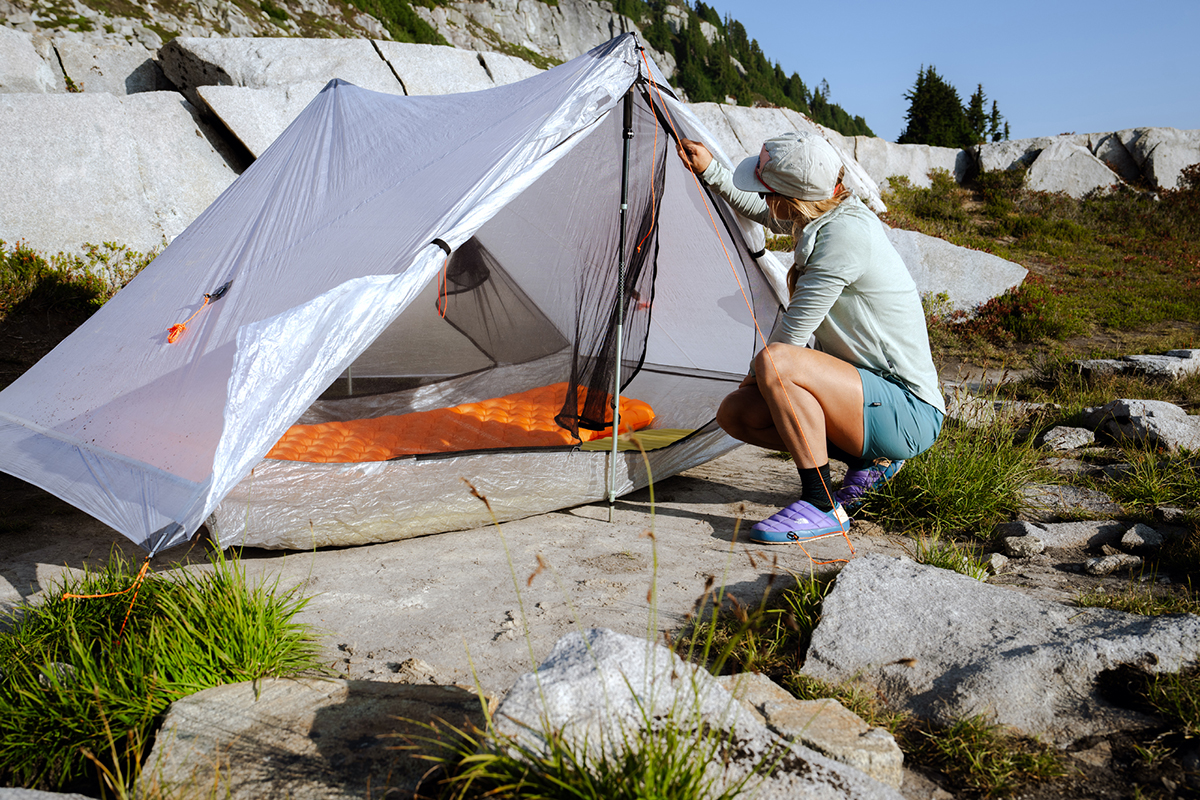
Backpacking tent prices generally correlate with weight: The lighter the fabric and materials, the more expensive the tent. From nearly 6-pound models like the 40 x 75D $299 REI Half Dome 2, we see a big price bump to designs like the 15 x 20D $550 Big Agnes Copper Spur UL2 at just 3 pounds. From here, prices generally plateau into the lightweight and ultralight categories among tents with similar fabrics, like the 15D Big Agnes Tiger Wall UL2 at $480. Specialized Dyneema designs see a big spike, like the $699 Hyperlite Unbound 2 that checks in at 1 pound 6 ounces and uses a mix of 0.55- and 0.8-ounce-per-square-yard materials. That said, there are plenty of outliers in each weight class, including Durston's X-Mid 2, which features an affordable 20D polyester build, checks in at 2 pounds 6.4 ounces, and costs $280.
Heavyweight: $/$$
Midweight: $$$
Lightweight: $$/$$$
Ultralight: $$$/$$$$

Collectively, the Switchback Travel staff has spent decades sleeping in tents. As a result, each of us has had enough time, information, and trial-and-error experiences to dial in what we’re willing to compromise in order to save on weight. And we’re generally in agreement when it comes to backpacking tents: Our lightweight and upper end of the ultralight categories offer the best compromise in terms of weight savings, feature sets, weather protection, and cost. We could certainly go lighter with a more specialized, non-freestanding UL tent, but the trade-offs are many—and often not worth it to us for a 1-pound weight savings. On the other hand, a few extra pounds could get us a more spacious and fully featured design, but most heavyweight models are overkill for trips when we’re spending most of our time outside.
But you might feel differently. Perhaps you’re a thru-hiker and every ounce counts during 30-mile days with two weeks of food on your back. Or maybe you’re a casual backpacker on a budget or camping close to your car. No matter what your situation, our aim is to provide you with all the facts so that you can come up with your own opinion. To help, we’ve provided a list of many of our favorite backpacking tents below, ranging from nearly 6 pounds down to under 2 (for the two-person versions). For a wider look at the market, our backpacking tent weight comparison chart includes virtually all two-person, three-season backpacking tents and shelters currently on the market.
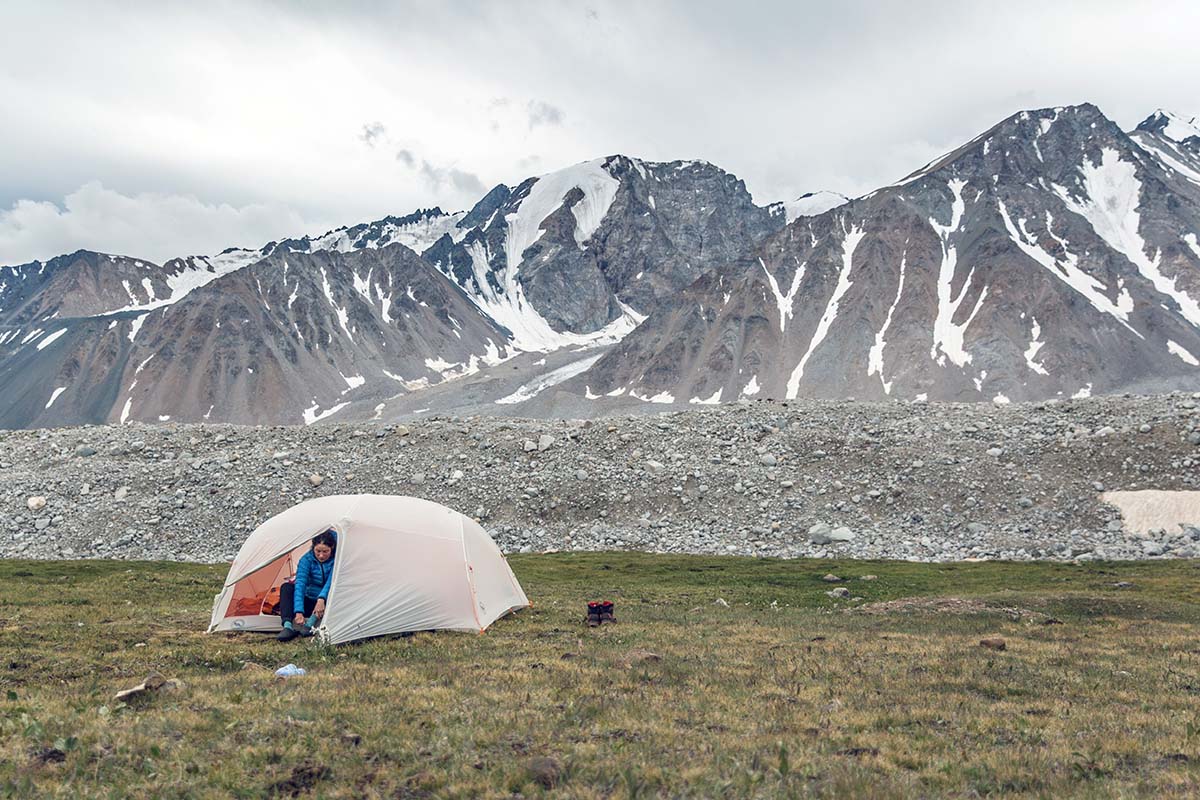
| Tent | Price | Packed Weight | Minimum Weight | Category | Floor Area | Floor Denier | Setup |
|---|---|---|---|---|---|---|---|
| REI Co-op Trail Hut 2 | $229 | 5 lb. 15.0 oz. | 4 lb. 14.0 oz. | Heavyweight | 31.7 sq. ft. | 66D | Free |
| Nemo Aurora 2 | $300 | 5 lb. 10.0 oz. | 4 lb. 11.0 oz. | Heavyweight | 32.4 sq. ft. | 75D | Free |
| Marmot Tungsten 2P | $249 | 5 lb. 4.7 oz. | 4 lb. 15.7 oz. | Heavyweight | 30.1 sq. ft. | 68D | Free |
| REI Co-op Half Dome 2 | $299 | 5 lb. 15.1 oz. | 4 lb. 13.3 oz. | Heavyweight | 31.8 sq. ft. | 75D | Free |
| Nemo Dagger Osmo 2P | $550 | 3 lb. 15 oz. | 3 lb. 5.0 oz. | Midweight | 30.6 sq. ft. | Unavailable | Free |
| Sea to Summit Telos TR2 | $449 | 3 lb. 10.7 oz. | 3 lb. 4.3 oz. | Midweight | 28.0 sq. ft. | 20D | Free |
| MSR Hubba Hubba LT 2 | $550 | 3 lb. 6.0 oz. | 3 lb. 0.0 oz. | Lightweight | 32.0 sq. ft. | 20D | Free |
| Big Agnes Copper Spur UL2 | $550 | 3 lb. 0.0 oz. | 2 lb. 10.0 oz. | Lightweight | 29.0 sq. ft. | 15D x 20D | Free |
| REI Co-op Flash Air 2 | $399 | 2 lb. 13.7 oz. | 2 lb. 6.5 oz. | Lightweight | 28.7 sq. ft. | 20D | Non |
| Big Agnes Tiger Wall UL2 | $480 | 2 lb. 8.0 oz. | 2 lb. 3.0 oz. | Lightweight | 28.0 sq. ft. | 15D | Semi |
| Nemo Hornet Osmo 2P | $450 | 2 lb. 8.0 oz. | 2 lb. 1.0 oz. | Lightweight | 27.5 sq. ft. | Unavailable | Semi |
| Durston X-Mid 2 | $280 | 2 lb. 6.4 oz. | 2 lb. 3.4 oz. | Lightweight | 33.2 sq. ft. | 20D | Non |
| Big Agnes Fly Creek UL2 | $400 | 2 lb. 4.0 oz. | 1 lb. 14.0 oz. | Lightweight | 28.0 sq. ft. | 20D | Semi |
| Nemo Hornet Elite Osmo 2P | $660 | 2 lb. 1.0 oz. | 1 lb. 11.0 oz. | Ultralight | 27.3 sq. ft. | Unavailable | Semi |
| Gossamer Gear The Two | $320 | 1 lb. 11.9 oz. | 1 lb. 7.5 oz. | Ultralight | 29.0 sq. ft. | 10D | Non |
| Big Agnes Tiger Wall Carbon | $1,800 | 1 lb. 11.0 oz. | 1 lb. 6.0 oz. | Ultralight | 27.0 sq. ft. | 0.5 oz/sqyd | Semi |
| Hyperlite Unbound 2 | $699 | 1 lb. 6 oz. | 1 lb. 6 oz. | Ultralight | 28.0 sq. ft. | 0.8 oz/sqyd | Non |
| Zpacks Duplex Zip | $729 | 1 lb. 4.2 oz. | 1 lb. 3.6 oz. | Ultralight | 28.0 sq. ft. | 1.0 oz/sqyd | Non |
When comparing tent weights, many manufacturers provide two specs: packaged weight and minimum or trail weight. Packaged weight refers to everything purchased with the tent, including the tent body, rainfly, poles, stuff sack, stakes, footprint, and guylines. Trail weight refers to only the essentials: the tent body, rainfly, and poles. Many ultralight hikers will leave items like the stuff sack and footprint behind, but most carry stakes and guylines for setup. In most cases, you can expect the final weight of your tent in your pack to be somewhere in between the two provided specs. We've listed the packaged weight where applicable in our in-line descriptions and in the chart above.
Back to How Light is Too Light? See Our Top Backpacking Tent Picks